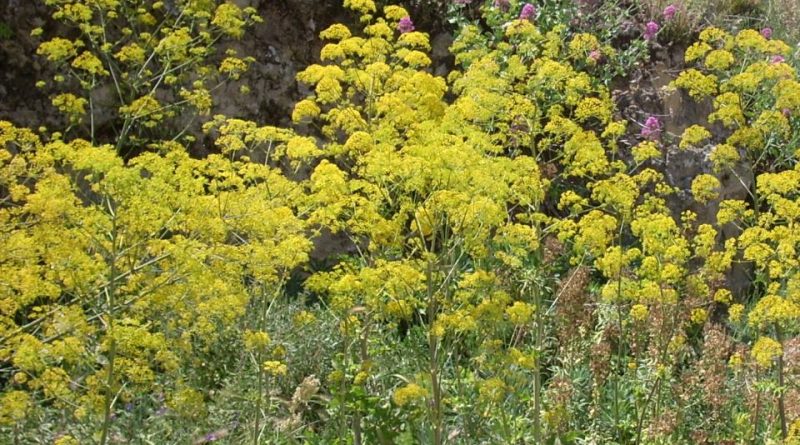Opopanax chironium
Opopanax chironium
The Opopanax (Opopanax chironium (L.) W.D.J. Koch) is a herbaceous species belonging to the Apiaceae family.
Systematics –
From a systematic point of view it belongs to:
Eukaryota Domain,
Kingdom Plantae,
Magnoliophyta Division,
Magnoliopsida class,
Order Apiales,
Apiaceae family,
Genus Opopanax,
Species O. chironium.
Basionimo is the term:
– Laserpitium chironium L ..
The terms are synonymous:
– Opopanax garganicus Burnat ex Lacaita;
– Parsnip opopanax L .;
– Ferulago geniculata Guss ..
Etymology –
The term Opopanax: means panacea juice, from the Greek ὀπός opós juice (of plants) and from πάναξ panacea, a mythical plant capable of healing all ills: a name then used by Celsus for a medicine used to treat certain diseases.
The specific epithet chironium: comes from Chiron, -onis the centaur Chiron, initiator of the medical art of healing with herbs.
Geographic Distribution and Habitat –
The Opopanax is a plant that grows in hot climates and is present in countries such as Iran, Italy, Greece, Turkey and Somalia; however it can also grow in cooler climates, although Opoponax grown in these climates are seen as inferior in quality.
In Italy it is frequently found in the Maritime Alps but also in the central and southern peninsula.
Its natural habitat is that of arid uncultivated and pastures.
Description –
Opopanax chironium is a perennial herb that grows up to 250 cm.
It has an enlarged yellow root, often with resinous encrustations at the apex.
The stem is erect, branchy, cylindrical, striated, with generally verticillated branches in the upper part.
The basal leaves are triangular in outline, 2 pinnatosette, with rounded apex and serrated margin.
The flowers are carried in umbrellas with 5-20 rays. Bracts and bracts present lanceolate. The petals are yellow and revolute.
Flowering is between June and July.
The fruit is an 8×5 mm polachenary (diachene), highly compressed elliptical, with the lateral ribs forming a whitish raised edge around the fruit. The mericarps are brown, slightly convex with clear lateral wings.
Cultivation –
Opopanax chironium is a perennial that is harvested in nature for local use as a medicine and source of materials.
However, it is an easy to cultivate plant that grows in many types of substrate, vegetating for many years even in a state of total abandonment.
The plant seems to resist temperatures down to -6 ° C.
Warm climates are still required for a good quality product.
The plants seem to be very tolerant to transplantation and propagation takes place by seed directly in the open field although it is advisable to sow them in pots or in seedbeds, in early spring, and transplant them in early summer.
Customs and Traditions –
Opopanax chironium is a medicinal plant that is currently considered less than it once was.
In the past it was widely used in the treatment of menstrual disorders, asthma, chronic visceral afflictions, etc.
From the stems a rubber (an oleoresin) is obtained which has antispasmodic and de-blocking properties.
This rubber is rare and expensive and is obtained through incisions in the roots at the base of the stems. Sometimes it gushes in the form of tears, but usually in lumps or irregular fragments, red-yellow in color, flecked with white on the outside, paler on the inside, and when it breaks, it exhibits white bits mixed with the mass. The aromatic resin is a gum, as mentioned, once used in medicine is now used in perfumery and in some incense. Rubber is flammable and burns with open flame.
Opopanax chironium is a rich source of furan and furan coumarins, the accumulation of which in all parts of the plant and especially in the roots is presumably responsible for some toxic properties of the species. Among other things, these substances are produced by plants mainly as a defense mechanism from predators.
Preparation Method –
The Opopanax is a plant used, especially in the past, in the medicinal field for the use of its resin which is obtained through incisions in the roots at the base of the stems.
Guido Bissanti
Sources
– Acta Plantarum – Flora of the Italian Regions.
– Wikipedia, the free encyclopedia.
– Useful Tropical Plants Database.
– Conti F., Abbate G., Alessandrini A., Blasi C. (ed.), 2005. An annotated checklist of the Italian vascular flora, Palombi Editore.
– Pignatti S., 1982. Flora of Italy, Edagricole, Bologna.
– Treben M., 2000. Health from the Lord’s Pharmacy, Advice and experiences with medicinal herbs, Ennsthaler Editore.
Warning: Pharmaceutical applications and alimurgical uses are indicated for informational purposes only, they do not represent in any way a medical prescription; therefore no responsibility is taken for their use for curative, aesthetic or food purposes.


